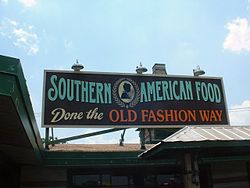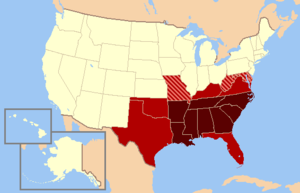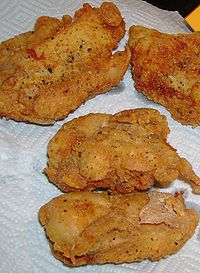- Cuisine of the Southern United States
-
The cuisine of the Southern United States is defined as the historical regional culinary form of states generally south of the Mason Dixon Line dividing Pennsylvania from Maryland and Delaware as well as along the Ohio River, and extending west to Southern Missouri, Oklahoma and Texas.[citation needed]
The most notable influences come from Scottish, Irish, French, Spanish, Native American, English, and African American cuisines. Cajun, Creole, Lowcountry, and Floribbean are examples of types Southern cuisine. In recent history, elements of Southern cuisine have spread north, having an effect on the development of other types of American cuisine.
Many items such as squash, tomatoes, corn (and its derivatives, including grits), as well as the practice of deep pit barbecuing were inherited from the southeastern American Indian tribes such as the Caddo, Choctaw, and Seminole. Many foods associated with sugar, flour, milk, eggs (many kinds of baking or dairy products such as breads and cheeses) are more associated with Europe.
The South's propensity for a full breakfast (as opposed to a Continental one with a simple bread item and drink) is derived from the English fry up[citation needed], although it was altered substantially. Much of Cajun or Creole cuisine is based on France, and on Spain to a lesser extent. Floribbean is more Spanish-based with obvious Caribbean influences, while Tex-Mex has considerable Mexican and Native American influences.
Contents
Traditional Southern dishes
A traditional Southern meal is pan-fried chicken, field peas (or black eyed peas), greens, mashed potatoes, cornbread, sweet tea and a dessert that could be a pie (sweet potato, chess, shoofly, pecan, and peach are traditional southern pies), or a cobbler (peach, blackberry or mixed berry are traditional cobblers).
Some other foods commonly associated with the South are mint juleps, pecan pie, country ham, fried chicken, chicken fried steak, grits, buttermilk biscuits (may be served with gravy or sorghum), pimento cheese, sweet tea, pit barbecue, catfish, fried green tomatoes,bread pudding, okra, butter beans, pinto beans, turnip greens, collard greens, mustard greens, and black eyed peas. A common snack food, in season, is boiled peanuts.
Fried chicken is among the region's best-known exports, though pork is also an integral a part of the cuisine, with Virginia ham being one renowned form. A traditional holiday get-together featuring whole hog barbecue is known in Virginia and the Carolinas as a "pig pickin'". Green beans are often flavored with bacon and salt pork, biscuits served with ham often accompany breakfast, and ham with red-eye gravy or country gravy is a common dinner dish. A bit of fatback is added to many vegetable dishes, especially greens, for flavoring.
It is not uncommon for a traditional southern meal to consist of only vegetables with no meat dish at all, although meat or meat products are often used in the cooking process. "Beans and Greens," which consists of either white or brown beans alongside a "mess" of greens has always been popular in most parts of the South. Turnip greens are generally prepared mixed with diced turnips and a piece of fatback. Another Southern staple is "Beans and Cornbread," consisting of pinto beans, stewed with ham or bacon, and cornbread. This is served sometimes with collard, turnip, or mustard greens. It is often said that Southerners tend to cook down their vegetables a little longer and/or use more seasoning than other Americans, but it often depends on the cook.
Southern desserts include many dishes such as strawberry shortcake, banana pudding, baked apple slices, sweet potato pie, apple pie, pumpkin pie, and many other pies utilizing fruits that are grown around the area.
Southern cuisine for the masses
 "Southern cuisine" is recognized by many Americans as suggested by this sign on a restaurant in the Florida Panhandle.
"Southern cuisine" is recognized by many Americans as suggested by this sign on a restaurant in the Florida Panhandle.
A niche market for Southern food along with American comfort food has proven profitable for chains, which have extended their market across the country, instead of staying solely in the South. Other Southern chains specialize in this type of cuisine, but have decided mainly to stay in the South. Pit barbecue is popular all over the American South; many rural places even sport several locally run locations, although this is rare in most other parts of the country. There are many individual family style restaurants based on the cuisine of the American South. Despite the down-home image of many Southern-influenced restaurants, some are more upscale. There are several chains with mass-produced items of Southern cuisine on their menus, such as Cracker Barrel, Kentucky Fried Chicken, Bojangles' Famous Chicken 'n Biscuits, Church's Chicken, Mrs. Winner's, Sonny's, and Popeye's.
Southern cuisine by region
Southern cuisine varies widely by region:
- In Southern Louisiana, there is Cajun and Creole cuisine. Louisiana is also a large supplier of hot sauces with its peppers, as well as being the largest supplier of crawfish in the country.[3]
- Rice was historically an important crop in the coastal areas of South Carolina, leading to local specialties like "Hoppin' John" (a mixture of rice and black-eyed peas flavored with salt pork) and Charleston Red Rice.
- Barbecue has many regional variations in the South. Barbecue sauce also varies by location.
- Virginia produces Smithfield ham, and is a major supplier of apples and peanuts.[citation needed]
Oklahoma has a reputation for many grain- and bean-based dishes, such as "cornbread and beans" or the breakfast dish biscuits and gravy. Mississippi specializes in farm-raised catfish, found in traditional "fish houses" throughout the state. Arkansas is the top rice-producing state in the nation, and is also noted for catfish, pork barbecue at restaurants, and chicken. Tennessee is known for its country ham and Memphis, TN is known for several famous barbecue restaurants and a major barbecue cooking competition held in May. Maryland is known for its blue and soft-shell crabs, and Smith Island Cake. Florida is home of the Key lime pie and swamp cabbage. Orange juice is the well-known beverage of the state. Georgia is known for its peaches, pecans, peanuts and Vidalia onions.
The Appalachian areas have ramps (onions and their relatives) and berries aplenty. Kentucky is famous for Burgoo and beer cheese. Texas specializes in chili, while Brunswick stew originated in the eastern parts of the South. Generally speaking, many parts of the Upper South specialize more in pork, sorghum, and whiskey, while the low country coastal areas are known for seafood (shrimp and crabs), rice, and grits. The western parts of the South like Texas and Oklahoma are more beef-inclined and the eastern parts lean more towards pork.
Creole and Cajun cuisine
Southern Louisiana developed significant culinary traditions: Louisiana Creole cuisine in southeastern Louisiana centered on New Orleans and Cajun cuisine in central to Acadiana in southwestern Louisiana. Both share influences of the traditional cuisine of France, though with greater use of rice. Both Cajun and Creole cuisine also had access to many native coastal animals, such as crawfish (commonly called crayfish outside the region), crab, oysters, shrimp, and fish. These seafoods were incorporated into their diets and are still seen today in the various dishes of the region. Fruits such as figs, plums and grapes are also grown in the region. Additionally, pecans and peanuts are native to the region, providing an alternative protein source.
Cajun cuisine
Cajun cuisine includes influence from the Acadia region in Canada. Rice, which could be used to stretch meals out to feed large families, became a major staple food. Today we still see that resourceful influence in many Cajun dishes which are served over a bed of rice. And again, stretchable corn was a major staple. In addition to the above listed foods, Acadian families were introduced to vegetables such as okra, which is a key ingredient in gumbos as well as many other Cajun and Creole dishes. Many Southerners also enjoy deep-fried or pickled okra.
Louisiana Creole cuisine
Southeastern Louisiana was more heavily influenced by France, Spain and Latin America. The region maintained more trade with France, and incorporated more recent French culinary traditions well into the 19th century. The major city of New Orleans, long known for its fine restaurants, allowed development of more gourmet variations of local dishes. In 1979, Cajun chef Paul Prudhomme opened a popular restaurant in New Orleans which started significant influence of Cajun food on to Creole traditions.
Lowcountry cuisine
The Lowcountry region of the coastal Carolinas, Virginia, and Georgia shares many of the same food resources as the Upper Gulf Coast—fish, shrimp, oysters, rice, and okra. Not surprisingly, it also displays some similarities to Creole and Cajun cuisines.
Appalachian cuisine
Travel distances, conditions, and poor roads limited most early settlements to only foods that could be produced locally. For farmers, pigs and chickens were the primary source of meat, with many farmers maintaining their own smokehouses to produce a variety of hams, bacons, and sausages. Seafood, beyond the occasionally locally caught fish (pan-fried catfish is much loved) and crawdads, were unavailable until modern times. However, Appalachia did offer a wide variety of wild game, with venison and squirrel particularly common, thus helping compensate for distance from major cities and transportation networks. As wheat flour and baking powder/baking soda became available in the late 19th century, buttermilk biscuits became immensely popular. Salt was primarily available from Saltville, Virginia, but until black pepper appeared, few other seasonings were used. Women were often herbalists, and used local plants like spicebush in seasoning. Chicory, which can be grown or gathered locally, was historically used as a coffee substitute during times when coffee was not freely available, such as during the American Civil War and the 2nd World War. The two primary sweeteners in Appalachia were sorghum and honey--the sugar cane molasses of the lowland South never was a dominant sweetener.
Today, a breakfast of buttermilk biscuits and sausage gravy is also very common throughout the region, as well as places Appalachian people have migrated. Pork drippings from frying sausage, bacon, and other types of pan-fried pork are typically collected and used for making gravy and in greasing cast-iron cookware. Chicken and dumplings and fried chicken remain much-loved dishes. Cornbread, corn pone, hominy grits, mush, cornbread pudding and hominy stew are very common foods, as corn is the primary grain grown in the Appalachian hills and mountains. Fruits that tend to be more popular in this area are apple, pears, and berries. Sweetened fried apples remain a common side-dish. Maple syrup and maple sugar is occasionally made in the higher elevations where sugar maple grows. Wild morel mushrooms and ramps (similar to green onions and leeks) are often collected. In Appalachia one may find festivals dedicated to the ramp plant . Home canning is a strong tradition here as well. Dried pinto beans are a major staple food during the winter months, used to make the ubiquitous ham-flavored bean soup usually called soup beans. Canning included green beans (half-runners, snaps) as well as shelly beans (green beans that were more mature and had ripe beans along with the green husks). Kieffer pears and apple varieties are used to make pear butter and apple butter. Also popular are bread and butter pickles, fried mustard greens with vinegar, pickled beets, chow-chow (commonly called "chow") and a relish called corn ketchup. Tomatoes are canned in large numbers, and fried green tomatoes are common. Along with sausage gravy, tomato gravy, a roux thinned with tomatoes, is very popular. A variety of wild fruits like pawpaws, wild blackberries, and persimmons are also commonly available in Appalachia.
See also
- Barbecue
- Tex-Mex cuisine
- Cuisine of the Southwestern United States
- Cuisine of the United States
- Soul food
- Southern Food & Beverage Museum
Notes
- ^ David Williamson. "UNC-CH surveys reveal where the ‘real’ South lies". http://www.unc.edu/news/archives/jun99/reed16.htm. Retrieved 22 February 2007.
- ^ http://www.pfly.net/misc/GeographicMorphology.jpg
- ^ Farmed Crawfish vs Wild Crawfish
References
- Domine, David. 111 Fabulous Food Finds: Best Bites in the Bluegrass. McClanahan Publishing House, 2011. ISBN 978-1934898123.
- Domine, David. Adventures in New Kentucky Cooking with the Bluegrass Peasant. McClanahan Publishing House, 2007. ISBN 0-913383-97-X.
- Domine, David. Splash of Bourbon, Kentucky's Spirit. McClanahan Publishing House, 2010. ISBN 978-1934898062
- Harris, Jessica. On the Side: More than 100 Recipes for the Sides, Salads, and Condiments That Make the Meal. Simon & Schuster, 2004. ISBN 0-7432-4917-8.
- The Junior League of Charleston. Charleston Receipts. Wimmer Brothers, 1950. ISBN 0-9607854-5-0.
- Lewis, Edna and Peacock, Scott. The Gift of Southern Cooking: Recipes and Revelations from Two Great American Cook. Knopf, 2003. ISBN 0-375-40035-4.
- Neal, Bill. Bill Neal's Southern Cooking. University of North Carolina Press, 1989. ISBN 0-8078-4255-9.
- Neal, Bill. Biscuits, Spoonbread, and Sweet Potato Pie. University of North Carolina Press, 2003. ISBN 0-8078-5474-3.
- Neal, Bill. Good Old Grits Cookbook. Workman Publishing Company, 1991. ISBN 0-89480-865-6.
- Snow, Constance. Gulf Coast Kitchens. Clarkson Potter/Publishers, 2003. ISBN 0-609-61011-2.
- Sohn, Mark F. Appalachian Home Cooking History, Culture, & Recipes Lexington: University Press of Kentucky. 2005. ISBN 0-8131-9153-X
- Taylor, John. Hoppin' John's Lowcountry Cooking. 1992. ISBN 0-553-08231-0.
- Walter, Eugene. American Cooking: Southern Style. New York: Time Life Books, 1971.
External links
- "Talk with your mouth full – what is Southern food?" CNN. December 2, 2010.
- Southern Barbecue Primer
- Southern Foodways Alliance
- Southern Food & Beverage Museum
Topics Culture | Cuisine | Geography | Economy | Government and Politics | History | Sports
States Alabama | Arkansas | Florida | Georgia | Louisiana | Mississippi | North Carolina | Oklahoma | South Carolina | Tennessee | Texas | Virginia | West Virginia
Major cities Atlanta | Birmingham | Charleston | Charlotte | Columbia | Dallas | Fort Worth | Greensboro | Houston | Jacksonville | Little Rock | Memphis | Miami | Nashville | New Orleans | Norfolk | Oklahoma City | Orlando | Raleigh | Richmond | Tampa | Tulsa
State capitals Atlanta | Austin | Baton Rouge | Charleston | Columbia | Jackson | Little Rock | Montgomery | Nashville | Raleigh | Richmond | Oklahoma City | Tallahassee
American cuisine Historical Regional Allentown, Pennsylvania · California · Cincinnati · Kentucky · Hawaii · Midwestern · Chicago · New England · New Mexico · New York City · Omaha · Pacific Northwest · Philadelphia · Puerto Rico · Southern · Cajun · Creole · Lowcountry · Barbecue in Texas · Tex-Mex · Floribbean · Southwest · Western
Ethnic American Chinese · Soul food · Native American · Pennsylvania Dutch · Italian American · Tlingit
Miscellanea Categories:
Wikimedia Foundation. 2010.






